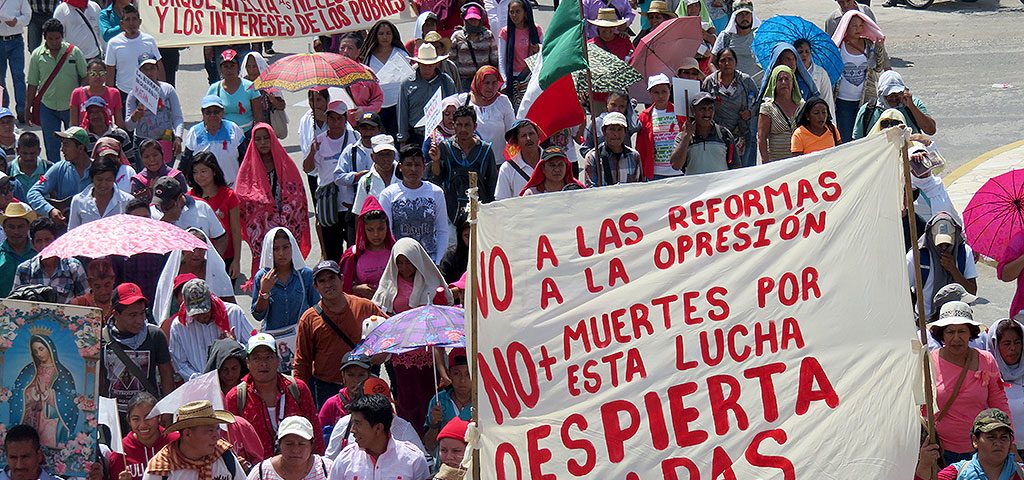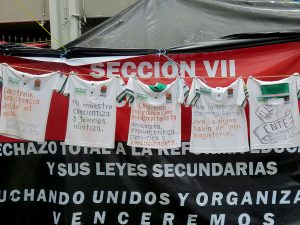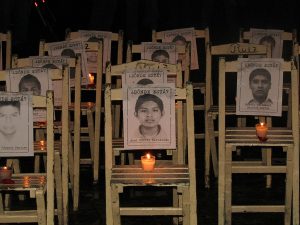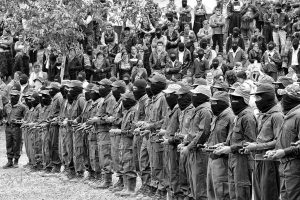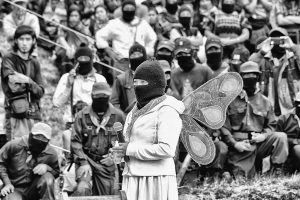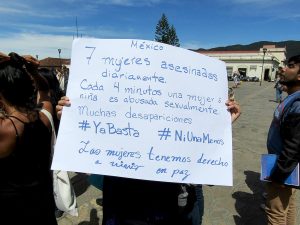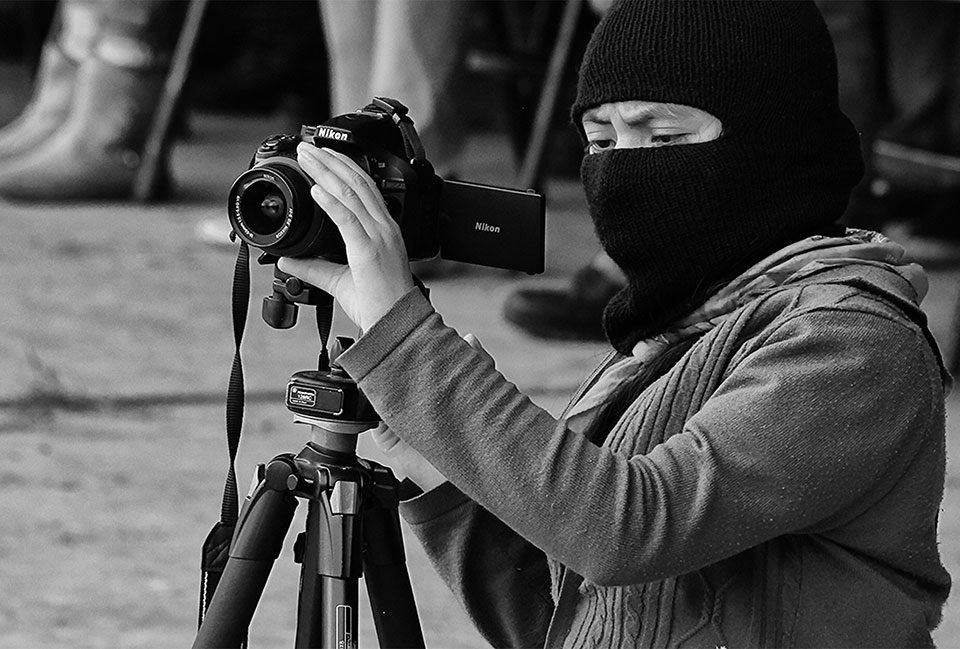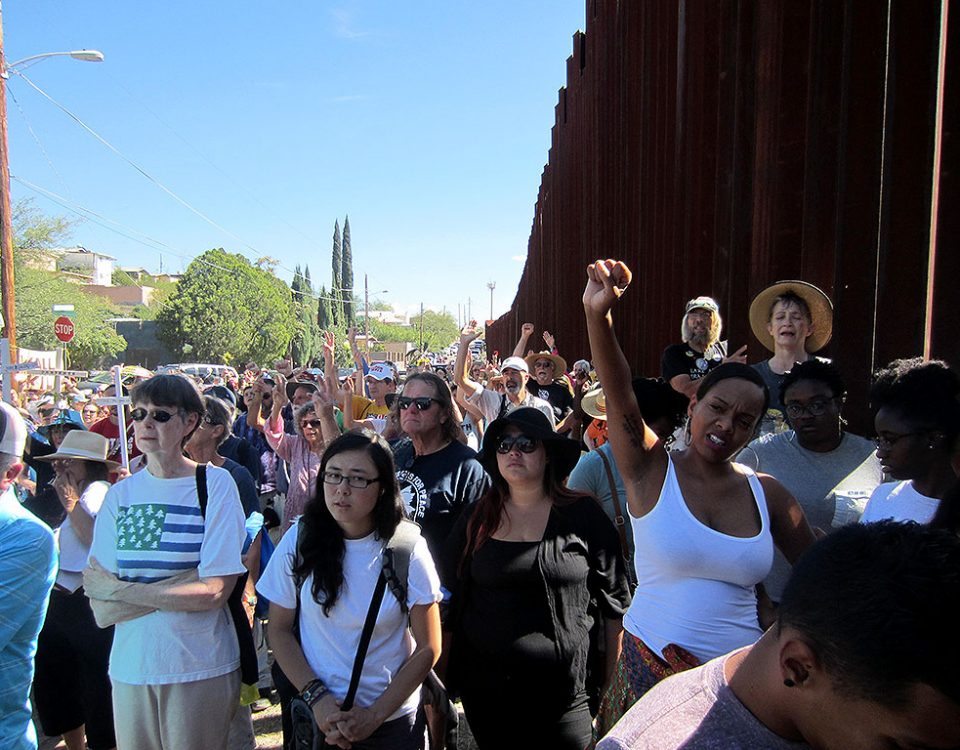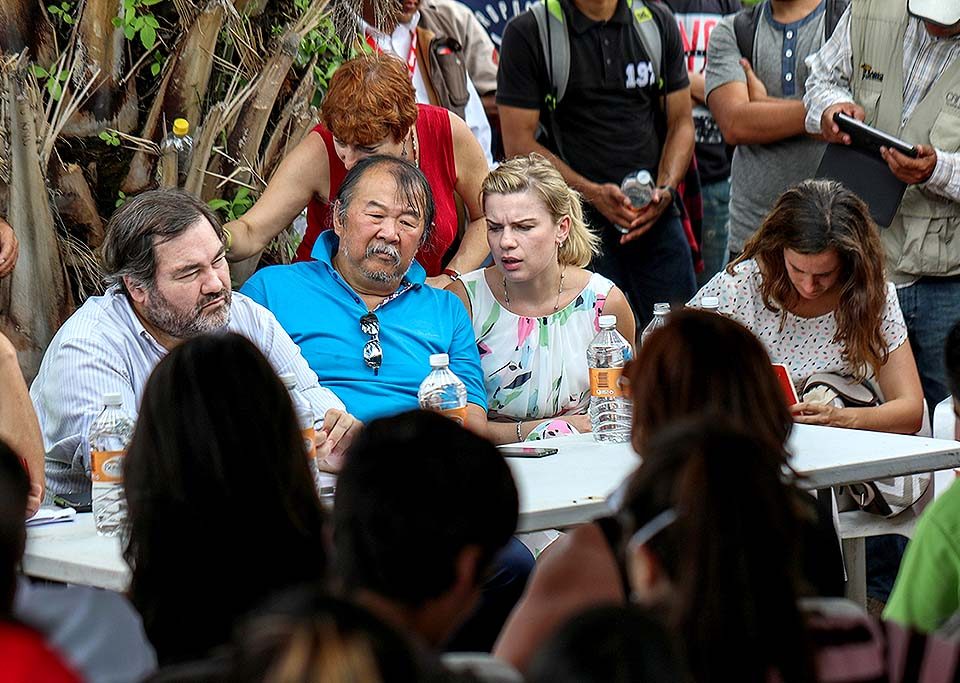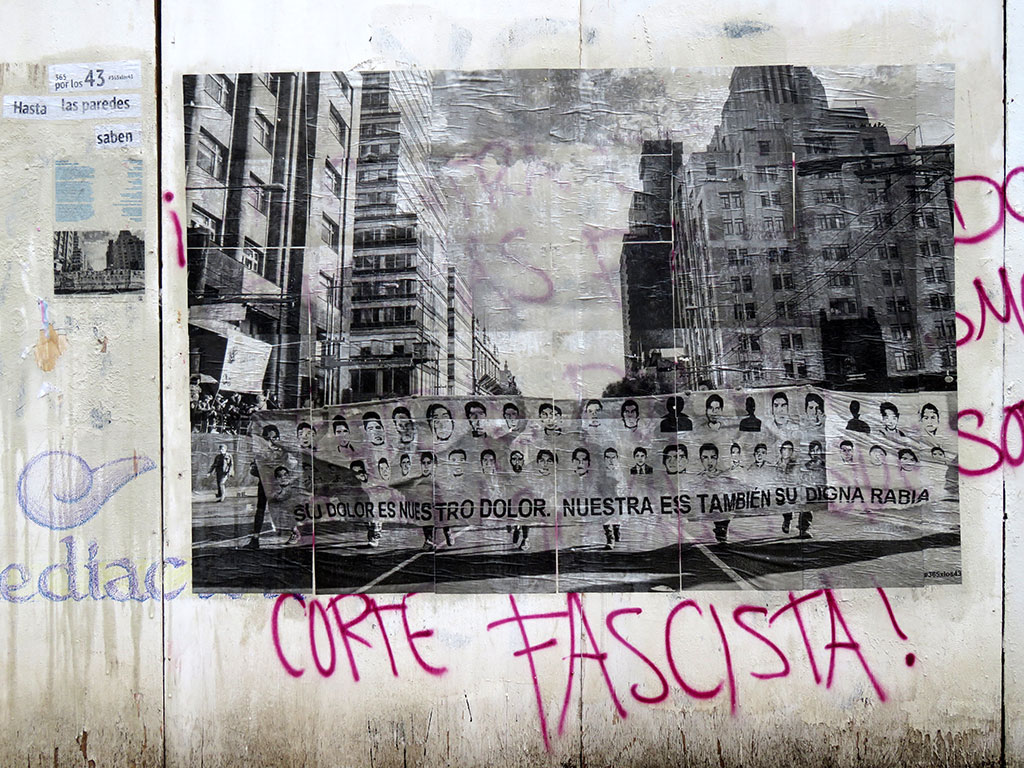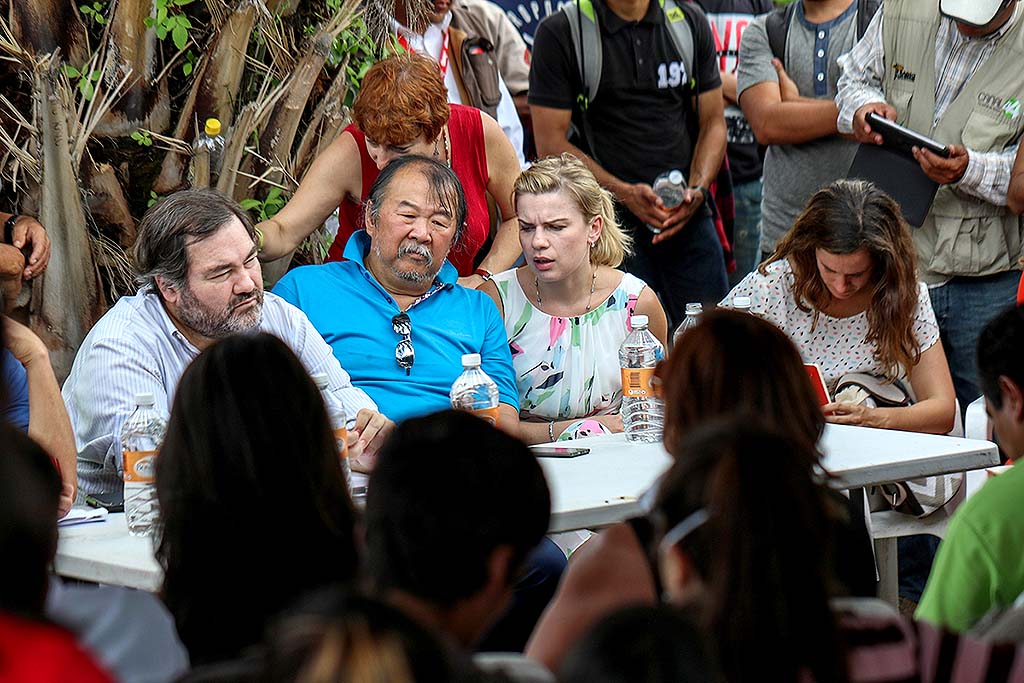From July to September, the teachers’ movement, opposed to the 2013 education reform bill, filled the front pages of the press. After the repressive events of Nochixtlán, Oaxaca, with eight dead and dozens injured, negotiating tables were opened between the Ministry of the Interior and representatives of the National Coordinator of Education Workers (CNTE in its Spanish acronym) in early July.
The CNTE demanded the “permanent suspension of the reform, the construction of a comprehensive model of education and the immediate repair of the harmful effects of the reform”. In this context, four Oaxacan teachers from Section 22 of the CNTE were transferred from a prison in Sonora to one in Oaxaca. They had been arrested in June for an alleged money-laundering offense. Their relatives say that the trials “are based on fabricated crimes, with the intention of keeping them in jail.”
In July, the blockade that the CNTE held in Chiapas on the Tuxtla Gutiérrez toll road outside San Cristobal de Las Casas was destroyed “by a group of 150 armed people.” According to those attacked, the aggressors belong to “two clashing groups: ALMETRACH (Chiapas Traditional Markets Tenants Association) – which works with the mayor of San Cristobal de Las Casas, Marco Cancino – as well as a group commanded by the mayor of San Juan Chamula.” These groups “of clash and the Municipal Police came to attack, they used (…) firearms and tear gas, respectively.” Five people were reported injured, four teachers and a journalist.
Even with the return to class scheduled for August 22nd, the CNTE chose to maintain its strike and blockades on highways and in commercial areas, mainly in Chiapas and Oaxaca. The CNTE denounced new threats of dismissals and salary deductions. They pointed out that government agencies threatened parents of beneficiaries of social programs so that they in turn put pressure on the teaching profession. Due to the announcement of an escalation of actions prior to the fourth presidential report in September, it was reported that hundreds of federal police arrived in Chiapas and Oaxaca.
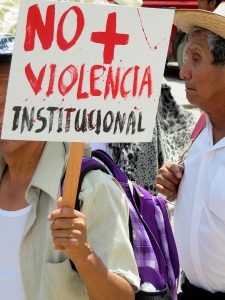
“No more Institutional Violence”, pilgrimage of the Believing People of the Diocese of San Cristobal de Las Casas, Tuxtla Gutierrez, Chiapas, July, 2016 © SIPAZ
On September 19th, protesting teachers in Chiapas began the school year after four months of strike. Those of Section 22 in Oaxaca had done the same on September 7th. Teachers’ leaders explained that their decision to return to class aims to help “strengthen the reorganization stage, push legislation to respond to our demand for repeal of education reform and continue with the construction of an alternative education proposal.” Aurelio Nuño, Secretary of Public Education, said that there will be dialogue in Michoacan, Guerrero, Oaxaca, and Chiapas “to be able to arrange local issues of these four states; that is, administrative problems.” He reiterated that under no circumstances would there be discussions on the repeal of the reform.
Fourth Government Report: Few Results
September 1st marked the publication of the Fourth Government Report. In August, a survey published by Reforma indicated that the level of popularity of Enrique Peña Nieto’s government of was only at 23%. Prior to the report, several media outlets criticized the performance of the current administration, questioning, among other things, the increase in violence, political scandals, human rights violations, and poor economic performance.
Secretary of the Interior, Osorio Chong, presented the report to Congress, stressing that the relationship between the Executive and Legislative has demonstrated an effective dialogue allowing the approval of “the reforms that Mexico demanded.” However, members of the opposition questioned the lack of results. For his part, Enrique Peña Nieto held a meeting with about 300 young people in which he highlighted the reduction in Internet prices and cell phone services; the creation of two million jobs, and the fact that Mexico is an attractive country for tourism and investment. However, although employment figures show an improvement, the “rate of critical conditions of employment” (employed population earning incomes below the minimum wage) has increased by approximately the same amount since 2014.
Shortly before, Peña Nieto was questioned about the visit to Mexico of the American presidential candidate, Donald Trump (he affirmed that “it allowed for the relevance that Mexico has for the US to be taken up”); on allegations of plagiarism of his undergraduate thesis (he said it was a “methodological error”); and on the increase in the price of gasoline (he said that “I never promised it wouldn’t rise”). Regarding human rights violations, he said that there is a commitment to seek clarification from the investigations of the Attorney General’s Office (PGR in its Spanish acronym). He stressed that progress has been made and that cases involving the armed forces and public security institutions have declined.
The Ayotzinapa Case: Waiting for Justice
On September 10th, the implementation of the Ayotzinapa Follow-up Mechanism was approved, based on the recommendations that the Interdisciplinary Group of Independent Experts (IGIE) stipulated in its reports on the disappearance of 43 students from the Normal Rural School during the night of September 26th and 27th of 2014, in Iguala, Guerrero. Also in September, the IGIE submitted its second report to the Subcommittee on Human Rights of the European Parliament and called for “human rights to take their place in the negotiations currently under way between the European Union (EU) and the Mexican government for the ‘modernization’ of the free trade agreement.” Several media have emphasized instead that European interests are an “example of the starkest neoliberalism” (Process 2072).
Shortly afterwards, the Miguel Agustin Pro Juarez Human Rights Center reported having received intimidation on Twitter just before the beginning of the march for the second anniversary of Ayotzinapa. They received the following message accompanied by an image of bullets: “I hope you do not stop at 4:00 at the Angel if you do not want your blood spilled. The Boss has already given the order.” The Observatory for the Protection of Human Rights Defenders emphasized that, “the tweet generated special attention by mentioning the “Boss”, whose name appears in the files of the investigation on the case of Ayotzinapa, which shows that the person is knowledgeable of the details of the case. The same Twitter profile that the threats come from has also issued threatening messages against a number of journalists.” The parents of the families of the 43 disappeared, who are joined by thousands of voices in Mexico and the world, have not ceased to demand truth and justice.
EZLN and CNI Communiqué “May the Earth Tremble at its Core”
From the 9th to the 13th of October, the Fifth National Indigenous Congress was held in San Cristobal de Las Casas, in the context of the 20th anniversary of the National Indigenous Congress (CNI). Around 500 delegates from 32 indigenous peoples communities of Mexico participated, as well as members and support bases of the Zapatista Army of National Liberation (EZLN) and other guests.
At the end of the event, the CNI and the EZLN published the communiqué “May the Earth Tremble at its Core” (paraphrasing the national anthem), in which they denounced 27 grievances that indigenous peoples face in the country. What caused the biggest stir was the announcement of the beginning of a consultation with its support bases to see the convenience of naming an indigenous council of government and to invite an indigenous woman to represent them in the presidential elections of 2018. The statement said that “[o]ur struggle is not for power, which we do not seek. Rather, we call on all of the originary peoples and civil society to organize to put a stop to this destruction and strengthen our resistances and rebellions (…) This is the time of dignified rebellion, the time to construct a new nation by and for everyone, to strengthen power below and to the anticapitalist left, to make those who are responsible for all of the pain of the peoples of this multi-colored Mexico pay.”
The controversy unleashed has been fueled by both critics and supporters. Andres Manuel Lopez Obrador, leader of the National Regeneration Movement (Morena in its Spanish acronym), recognized that the EZLN has every right to participate in the political life of the country. However, he ruled that this proposal was a maneuver “to play the game of the government.” Francisco Garate of the National Action Party (PAN in its Spanish acronym) considered the initiative as a “fancy” and “nonsense”: “Today the country’s indigenous population is less than one percent and disseminated in villages that go from Sonora to Yucatan.”
In the communiqué “Questions without Answers, Answers without Questions, Councils and Counsel”, the EZLN spoke of the criticisms made so far. It asked, among other things, “To what degree does the proposal that an indigenous governing council (concejo with a “c”),[iii] that is, a collective and not an individual, be in charge of the federal executive bolster-presidential-rule-become-complicit-in-the-electoral-farce-contribute-to-reinforcing-bourgeois-democracy-play-to-the-oligarchy-and-to-Yankee-Chinese-Russian-Judeoislamic-millenarian -imperialism-in-addition-to-betraying-the-highest-principles-of-the-global-proletarian-revolution? (…)How solid can the Mexican political system be (…) if, when someone says publicly that they are thinking about something, that they are going to ask their peers what they think of what they are thinking, the entire political party system becomes hysterical?” The consultation will finish at the end of December, opening a new session of the CNI in Chiapas, during some days in the middle of the “L@s Zapatistas and ConCiencias por la Humanidad” encounter.
CHIAPAS: Post-Electoral Political Party Conflicts
Since the last municipal elections, the victory of the Green Ecologist Party (PVEM) has unleashed several conflicts in areas formerly dominated by the Institutional Revolutionary Party (PRI). Among the most notable cases, the mayor of San Juan Chamula, Domingo Lopez, was assassinated in July. He had been mayor for the PRI, and obtained his second mandate for the Green Party. During his campaign, he promised to raise the annual payment to local craftspeople. He began to distribute 7,000 pesos to each woman in some communities, but there was not enough for all, sparking the conflict that led to his murder.
In August, the Electoral Tribunal of the Judiciary of the Federation (TEPJF in its Spanish acronym) ordered Rosa Perez Perez (PVEM) to be reinstated as mayor of Chenalho. Last May, after several weeks of protests, a group of protesters detained the president of Congress and a local deputy as a means of pressure. Before the decision of the TEPJF, the coadjutor Bishop of the Diocese of San Cristobal, Enrique Diaz Diaz, affirmed that we do not “agree with the violent ways in which she was removed and now with fear we hear about this situation that she will be reinstated.” He said that the Chenalho case “is tainted from the beginning”, because “we cannot say that the elections have been completely free”.
In September, the TEPJF also ordered the return of Maria Gloria Sanchez Gomez (PVEM) as Oxchuc’s mayor, after she was forced to resign last February. Immediately after, more than 500 Tseltales closed the San Cristobal-Ocosingo road for several hours. The opposition group accuses Sanchez Gomez of having established a chiefdom in the municipality along with her husband by alternating the post for several periods. Prior to her dismissal, violent acts took place, among them the retention of civil servants as well as the burning of houses and vehicles in Oxchuc.
Human rights: Structural Violence behind Concrete Cases
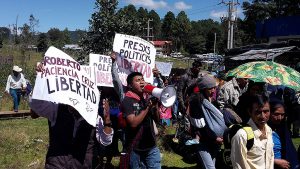
Pilgrimage outside the San Cristobal de Las Casas Chiapas prison, to denounce the “unjust enforcement of justice that is lived in the Mexican State” © SIPAZ
In September, civil organizations reported that young Maximiliano Gordillo Martinez, who was missing since May when he was detained at a immigration checkpoint in Tabasco, was found alive. They denounced that, “since his detention … until the day of his location … he was a victim of crimes and serious violations of his human rights, responsibility of the Mexican State. (…) what Maximiliano has lived through reveals to us the magnitude of the structural, institutional and social violence suffered by Mexican people and those from other countries during their journey and destinations in the interior of our country.”
In October, Margarita Gomez Lopez and David Hernandez Gomez, indigenous Tsotsiles, detained since 2014, were victims of an unfair trial. The Fray Bartolome de Las Casas Human Rights Center stated that their case “represents a pattern of human rights violations that systematically violates a particularly indigenous population in extreme poverty, who are unprotected by a system that uses torture as a method of fabricating culprits.” Shortly afterwards, the Parish of Teopisca, to which the couple belong, called a Eucharistic celebration in front of San Cristobal prison to denounce the “unjust enforcement of justice that is lived in the Mexican State”, in particular the case of Roberto Paciencia Cruz, who was then held in this same prison.
Land and Territory: Current Conflicts, Conflicts to Come
Since late September, several communities in Acacoyagua and Escuintla in the Soconusco region have maintained a road blockade to prevent mining companies from continuing mining exploration and exploitation, as well as denouncing river pollution and health problems they have caused. The Mexican company El Puntal SA de CV, which operates an open-pit mine, called Casas Viejas, in Acacoyagua is one of the worst since it is located only 200 meters from the water catchment/collection system that supplies the community. “Unfortunately, Casas Viejas is only one of the four active mining projects in the municipality, which includes a total of 13 mining concessions (more than 36,000 hectares), and to these are added the eight concessions located in the neighboring municipality of Escuintla (more than 15,000 hectares)”, Otros Mundos reported.
In October, the Energy MInistry initiated a process of consultation with the Zoque communities of the municipalities of Francisco Leon, Ixtacomitan, and Pichucalco to be able to open twelve hydrocarbon wells that are in tender and that would affect about 80,000 hectares. The Movement of Native Peoples in Resistance (Mopor in its Spanish acronym) said that most communities oppose such exploitation.
GUERRERO: Between Violence and Impunity
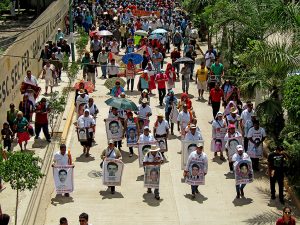
“We will Move Mountains to Get justice and Truth”, banner in the framework of the Anniversary of the Tlachinollan Human Rights Center, Tlapa de Comomfort © SIPAZ
In August, the 22nd anniversary of the Tlachinollan Human Rights Center was celebrated. Its director, Abel Barrera, referred to violence in the state: “Here we have an average of 6.8 deaths a day … because of the violence and indolence of the authorities, who are linked to that delinquent power that has entangled us for three decades. “
In October, about 2,000 people from various social organizations marched in Chilpancingo. They demanded, among other things, the release of the promoter of the Community Police of Tixtla, Gonzalo Molina Gonzalez, from the Zitlaltepec House of Justice community police, Samuel Ramirez Galvez; as well as the advisor of El Paraíso House of Justice, Arturo Campos Herrera. Shortly after, the Regional Coordinator of Community Authorities – Community Police (CRAC-PC in its Spanish acronym) marked its 21st anniversary. It called for respect for the community police and freedom for their prisoners “unjustly accused of kidnapping”, despite the fact that several international treaties recognize the right of indigenous peoples to have their own justice and security system.
In October, about 100 people held a ceremony at Mexcalpetec in Atoyac to remember Rocio Mesino Mesino, a former leader of the Peasant Organization of the Southern Highlands (OCSS in its Spanish acronym), three years after her assassination there. At the end of the commemoration, the OCSS demanded a gender alert in the state given the current increase of femicides. This same month, also under the umbrella of impunity, the Decade Solidarity Network Against Impunity reported that the Mexican State requested the IACHR to declare the case of the massacre of 11 indigenous people and a student in El Charco, Ayutla, by Mexican soldiers in 1998 “inadmissable.”
OAXACA: Repressive Acts do not Represent an Isolated Situation
In July, several civil organizations presented the “Preliminary Report on Human Rights Violations on June 19th in Oaxaca” to “make known the chronology of events and violations of human rights that occurred in Nochixtlan, and places near the City of Oaxaca” in the context of the repression against teachers. According to Proceso, these repressive acts do not represent an isolated situation, but in Oaxaca, “at least 44 extrajudicial executions, 12 forced disappearances, 220 arbitrary arrests. and 29 assaults in different modalities have occurred in the last five and a half years. These are about 300 attacks, mostly aimed against leaders of organizations, notably opponents of government projects, infrastructure or public policies.”
The topic ofLand and Territory remains at the center of many social conflicts. In July, agrarian authorities, communities, and civil and social organizations met in Oaxaca to establish the State Day of Rebellion Against Mining. They expressed their “decision to fight together to stop these abuses and affirm our own ways of living and governing.” In October, more than 500 people from seven municipalities in the Tehuantepec Isthmus spoke out against the open-pit mine that Canadian companies intend to install on 30,000 hectares of the area, including 19,000 hectares of forest in Chimalapas. They unanimously agreed to form a Regional Defense Committee against Mining and denounced that the government sold the permits without consultation.
In terms of human rights, there have been 75 cases of femicide this year. According to Consorcio Oaxaca, 500 femicides have been registered during Gabino Cue Monteagudo’s term of office, almost twice as many as compared to the previous six years. The Rosario Castellanos Women’s Studies Group claimed that the “government’s discourse remained in formalities despite the commitments that the governor had with social organizations.”
In October, Juan Macario Bautista Ramirez was arrested in the United States when he was identified as one of the perpetrators of the murder of Bety Cariño and Jyri Jaakkola (Finnish) when they were part of a humanitarian caravan headed to San Juan Copala in the Triqui area in 2010. Karla Michell Salas, who is legally following the case, told Desinformémonos that “the current political context in Oaxaca is worrying, the return of the PRI to state government and also the recent appointment of Rene Juarez Cisneros, a PRI politician and ex-governor of Guerrero, (…) as the new deputy secretary of government in the Ministry of the Interior, which could influence the outcome of the trials of the five persons detained until now and whether or not the eight arrests warrants pending are served.”

